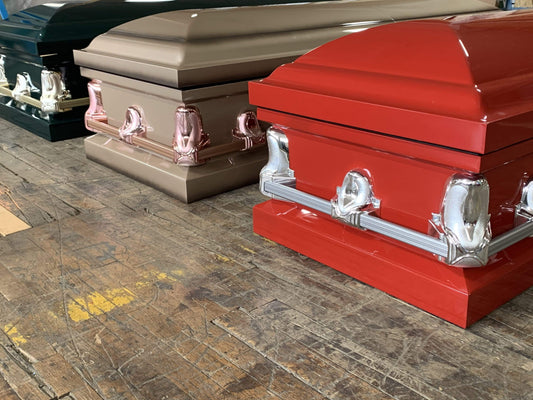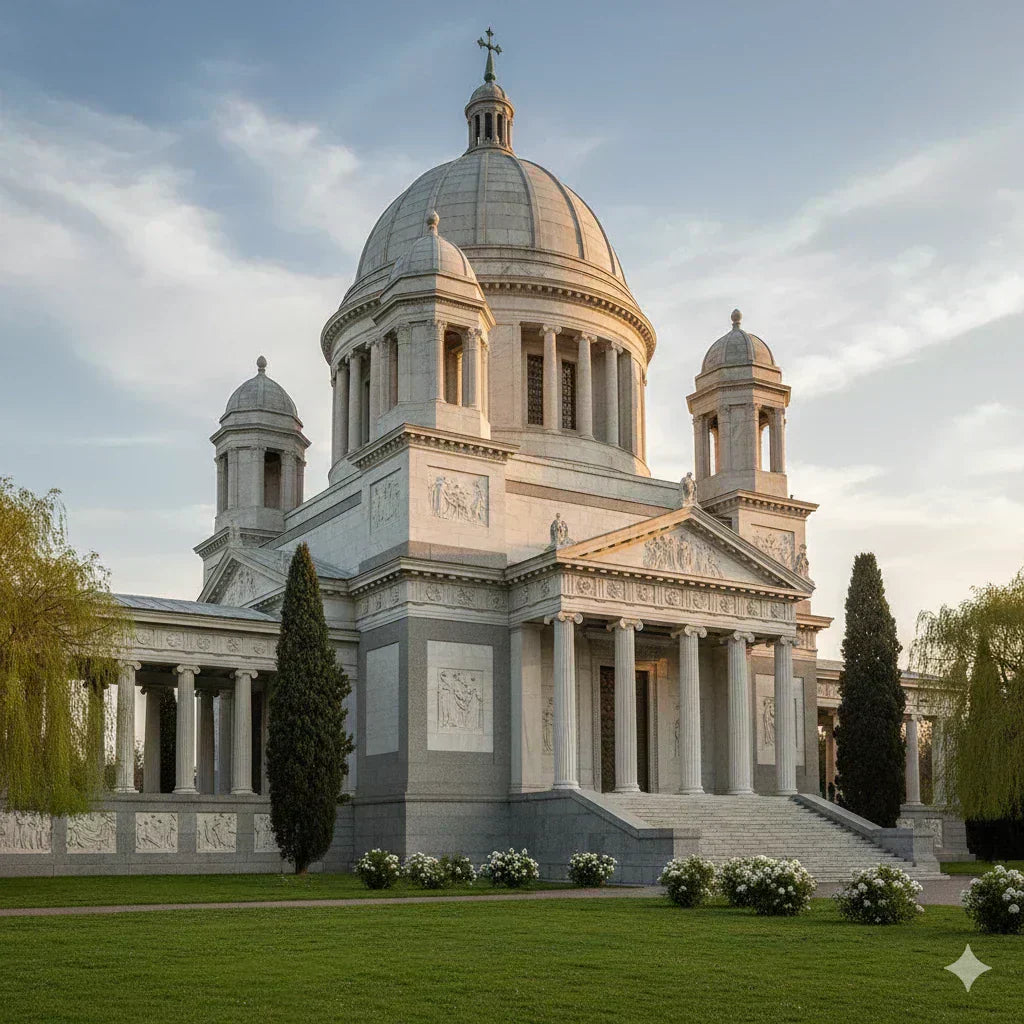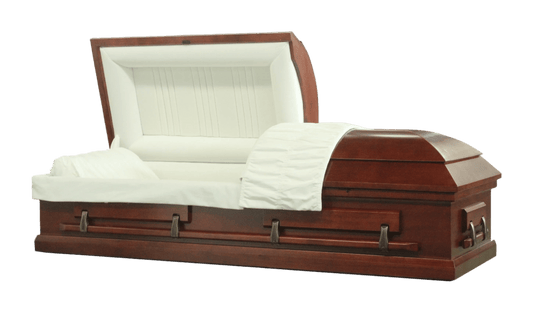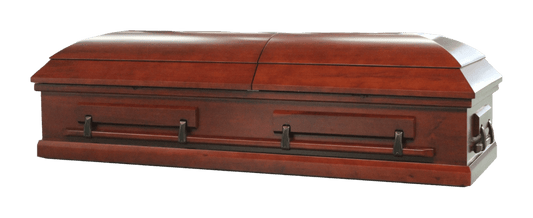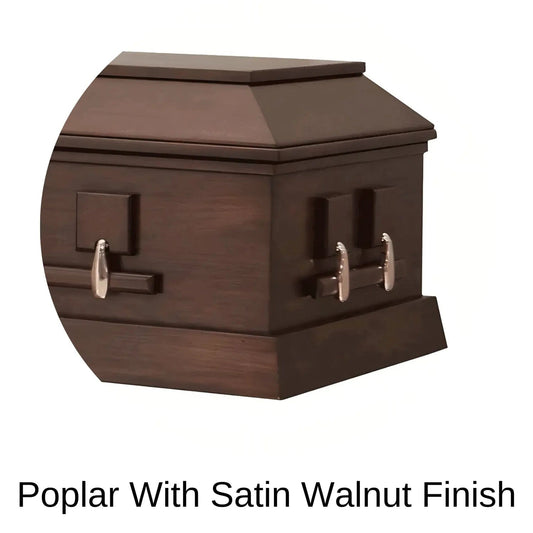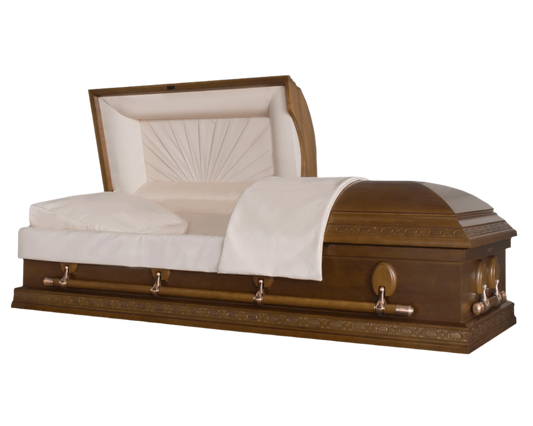What Is a Mausoleum?
A mausoleum is a free-standing structure built to hold the remains of a person or multiple people above the ground. Unlike traditional burials where the casket is placed underground, a mausoleum provides an enclosed space — often made of stone or marble, to protect and preserve the casket inside it.
These structures can vary widely in size and design, from small, private spaces for a single family to grand, public monuments that hold many individuals. You’ll often find mausoleums in cemeteries, though private family estates may also have their own.
Simple Definition of a Mausoleum
In simple words, a mausoleum is an above-ground tomb.
Inside, you’ll find one or more crypts — compartments that hold caskets or urns.
It offers families a way to keep their loved ones’ remains safe, dry, and easily accessible for visits.
The word mausoleum actually comes from Mausolus, an ancient Greek ruler, whose elaborate marble tomb — the Mausoleum at Halicarnassus — became one of the Seven Wonders of the Ancient World. Ever since, any above-ground burial structure has been known as a mausoleum.
How a Mausoleum Works
The design of a mausoleum is simple but meaningful.
Inside the structure are chambers or “crypts,” each sealed with a marble or bronze plate engraved with the person’s name and details. The body, usually in a casket, is placed in the crypt. Some mausoleums are designed to also include columbarium niches for cremation urns.
The main difference between a mausoleum and a burial vault is that a burial vault is underground, placed in the soil to protect a casket from ground pressure — while a mausoleum holds the casket above ground, inside a secure, ventilated structure.
Types of Mausoleums
There isn’t just one kind of mausoleum. Families can choose from different types based on space, budget, and personal preference.
1. Private Mausoleum
A private mausoleum is built for one individual or a single family. It offers complete privacy and the freedom to personalize the design — from the structure to the inscriptions and decorations. Many families see it as a legacy, a lasting place to honor generations together.

(Image Source: Brown Memorials)
2. Public or Community Mausoleum
These mausoleums are open to the public and contain crypts available for purchase by different families. They are maintained by the cemetery and often located indoors, making them comfortable to visit in all weather.

(Image Source: riversidecemetery)
3. Garden Mausoleum
Built outdoors, a garden mausoleum combines architecture with landscaping. The crypts are typically located in open air, surrounded by pathways, gardens, and benches for visitors.
4. Family Mausoleum
A family mausoleum is built to hold the remains of several family members — sometimes spanning multiple generations. It reflects unity, legacy, and shared remembrance.
5. Columbarium
A columbarium is a type of mausoleum specifically designed to store cremation urns rather than caskets. Each urn is placed in a small compartment, known as a niche, with a plaque or nameplate.

Mausoleum vs. Burial: What’s the Difference?
| Aspect | Mausoleum (Above Ground) | Traditional Burial (Underground) |
|---|---|---|
| Placement | Casket or urn kept above ground in a building | Casket buried below the surface |
| Protection | Fully sealed from weather and soil conditions | Exposed to natural elements |
| Accessibility | Can be visited year-round, regardless of weather | May depend on outdoor conditions |
| Cost | Higher upfront, lower long-term family cost | Lower initial cost, recurring maintenance fees |
| Preservation | Slower decomposition, more controlled | Natural decomposition in soil |
| Symbolism | Eternal monument or family legacy | Traditional return to earth |
A mausoleum offers a sense of permanence and dignity, while traditional burials appeal to families who prefer a simpler, more natural resting place. The right choice depends on your family’s traditions, preferences, and values.
Related Reading: Difference Between Cemetery, Graveyard And Mausoleum
Why Families Choose Mausoleums
There are several reasons why people around the world prefer mausoleums as a final resting place:
-
Protection from the elements: Mausoleums safeguard the remains from ground moisture and changing weather conditions.
-
Ease of visitation: Families can visit comfortably at any time, even during rain or winter.
-
Family unity: A single structure allows generations to rest together.
-
Personalization: From stained-glass windows to carved stone designs, a mausoleum can reflect a family’s story.
-
Longevity: Properly maintained mausoleums can last for centuries, preserving family history for future generations.
Famous Mausoleums Around the World
The world is filled with extraordinary mausoleums that reflect different cultures and beliefs.
-
Taj Mahal (India): Perhaps the most famous of all, this marble monument in Agra was built by Emperor Shah Jahan in memory of his wife Mumtaz Mahal.

-
Mausoleum at Halicarnassus (Turkey): The original “mausoleum,” built for King Mausolus in 350 BC — one of the Seven Wonders of the Ancient World.

-
The Lincoln Tomb (Illinois, USA): Built to honor President Abraham Lincoln, it houses his remains and those of his family.

-
The Pantheon (Paris, France): A grand mausoleum containing the remains of Marie Curie, Victor Hugo, and many others.

These examples show how mausoleums have served as powerful symbols of love, respect, and remembrance throughout history.
Cost of a Mausoleum
Building or purchasing a mausoleum can range widely in cost.
-
Community mausoleums: start around $4,000–$10,000 for a single crypt.
-
Private or family mausoleums: can range from $25,000 to $500,000 or more, depending on size, design, and materials used.
Costs are influenced by:
-
The number of crypts or niches
-
Building materials (granite, marble, limestone)
-
Customization (inscriptions, glasswork, sculptures)
-
Location within the cemetery
-
Maintenance and perpetual care fees
While the initial expense is higher than a traditional burial, a family mausoleum often becomes cost-effective over generations, since it can hold several loved ones in one place.
Maintenance and Regulations
Owning or building a mausoleum also comes with maintenance considerations.
Cemeteries usually have guidelines around design, construction, and care.

Common aspects include:
-
Regular cleaning of exterior stonework
-
Inspection and sealing of crypts to ensure ventilation
-
Landscaping or lighting upkeep (for garden mausoleums)
-
Compliance with local building codes and cemetery rules
Some cemeteries include “perpetual care” — a one-time fee covering long-term upkeep of the structure.
Are Mausoleums Only for the Wealthy?
It’s a common myth that mausoleums are only for the rich or famous.
Today, community or shared mausoleums make this option accessible for almost every family. These structures provide the same level of dignity and protection, often at a fraction of the cost of a private one.
Choosing a mausoleum is more about personal preference — how a family envisions remembrance and connection — rather than wealth or status.
Mausoleum or Cremation: Which Should You Choose?
Some families prefer above-ground entombment, while others choose cremation. Both allow for personalization, remembrance, and legacy. In fact, some mausoleums include columbarium sections specifically designed for cremated remains, allowing both burial and cremation options within one space.
If you’re exploring cremation, consider a columbarium niche or a personalized urn that can be placed inside a mausoleum.
FAQs About Mausoleums
1. What’s inside a mausoleum?
Inside a mausoleum are sealed crypts that hold caskets or urns. Each crypt is marked with a nameplate, similar to a headstone.
2. How long does a body last in a mausoleum?
Because the structure protects from air, moisture, and soil, decomposition happens much slower than underground burials. The remains can stay preserved for decades or even centuries.
3. Can a cremation urn be placed inside a mausoleum?
Yes. Many mausoleums include columbarium niches that are designed to hold urns securely above ground.
4. How is a mausoleum different from a tomb?
A tomb can be either underground or above ground. A mausoleum specifically refers to an above-ground building that houses one or more tombs or crypts.
5. Are mausoleums environmentally friendly?
While traditional mausoleums use stone and concrete, modern versions often incorporate sustainable materials and natural ventilation systems, reducing long-term environmental impact.
6. Can anyone build a mausoleum on private land?
It depends on local zoning and health regulations. Most families build mausoleums within cemeteries to ensure legal compliance and maintenance.
Final Thoughts
A mausoleum is more than a structure — it’s a symbol of memory, heritage, and love that endures across generations. Whether it’s a single crypt or a family estate, it offers comfort in knowing your loved ones rest in a protected, dignified space.
At Titan Casket, we understand how personal every end-of-life decision is. From caskets and urns to funeral planning resources, we’re here to help families find clarity, comfort, and choice.

![Upgrade to Premium Weight [18-gauge steel]](http://titancasket.com/cdn/shop/products/casketthicknesswithnumbers.png?v=1680642906&width=533)
